Medico-Legal and Ethical Aspects of Nursing Practice in Saudi Arabia
VerifiedAdded on 2023/06/11
|12
|3574
|262
Essay
AI Summary
This essay provides an overview of the medico-legal and ethical challenges faced by nurses in Saudi Arabia, addressing key areas such as workplace violence, malpractice, negligence, and breach of confidentiality. It highlights the unique aspects of nursing practice within the Saudi cultural and legal context, referencing the Saudi Arabia Ministry of Health (MOH) guidelines and Islamic Sharia law. The essay further explores the causes and consequences of these issues, including understaffing, communication failures, and the impact on patient care. It also touches upon the legal framework for addressing medical negligence and the importance of maintaining patient confidentiality within the Saudi healthcare system. The conclusion emphasizes the need for ongoing efforts to improve ethical practices and reduce legal risks in nursing within Saudi Arabia.
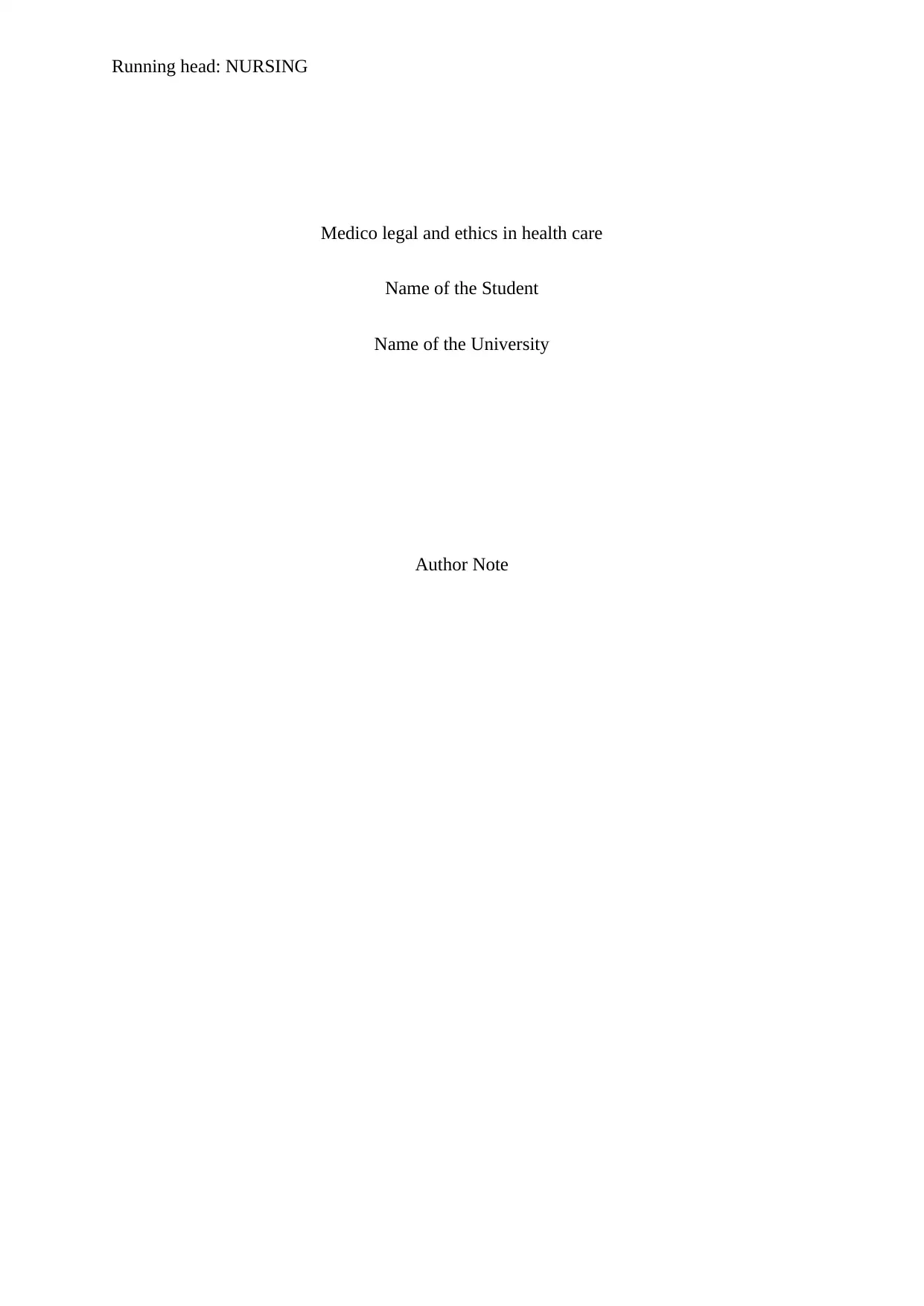
Running head: NURSING
Medico legal and ethics in health care
Name of the Student
Name of the University
Author Note
Medico legal and ethics in health care
Name of the Student
Name of the University
Author Note
Paraphrase This Document
Need a fresh take? Get an instant paraphrase of this document with our AI Paraphraser
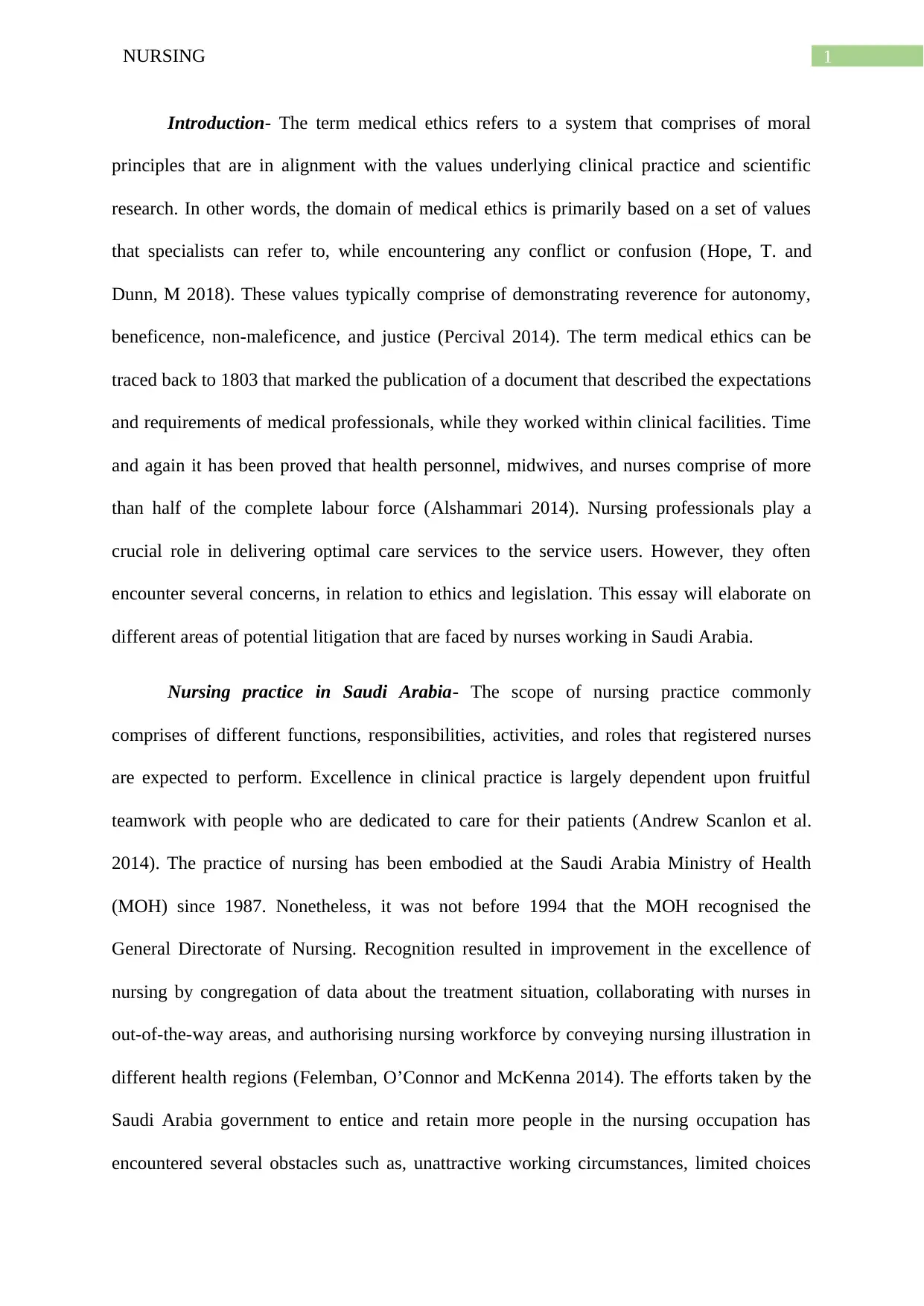
1NURSING
Introduction- The term medical ethics refers to a system that comprises of moral
principles that are in alignment with the values underlying clinical practice and scientific
research. In other words, the domain of medical ethics is primarily based on a set of values
that specialists can refer to, while encountering any conflict or confusion (Hope, T. and
Dunn, M 2018). These values typically comprise of demonstrating reverence for autonomy,
beneficence, non-maleficence, and justice (Percival 2014). The term medical ethics can be
traced back to 1803 that marked the publication of a document that described the expectations
and requirements of medical professionals, while they worked within clinical facilities. Time
and again it has been proved that health personnel, midwives, and nurses comprise of more
than half of the complete labour force (Alshammari 2014). Nursing professionals play a
crucial role in delivering optimal care services to the service users. However, they often
encounter several concerns, in relation to ethics and legislation. This essay will elaborate on
different areas of potential litigation that are faced by nurses working in Saudi Arabia.
Nursing practice in Saudi Arabia- The scope of nursing practice commonly
comprises of different functions, responsibilities, activities, and roles that registered nurses
are expected to perform. Excellence in clinical practice is largely dependent upon fruitful
teamwork with people who are dedicated to care for their patients (Andrew Scanlon et al.
2014). The practice of nursing has been embodied at the Saudi Arabia Ministry of Health
(MOH) since 1987. Nonetheless, it was not before 1994 that the MOH recognised the
General Directorate of Nursing. Recognition resulted in improvement in the excellence of
nursing by congregation of data about the treatment situation, collaborating with nurses in
out-of-the-way areas, and authorising nursing workforce by conveying nursing illustration in
different health regions (Felemban, O’Connor and McKenna 2014). The efforts taken by the
Saudi Arabia government to entice and retain more people in the nursing occupation has
encountered several obstacles such as, unattractive working circumstances, limited choices
Introduction- The term medical ethics refers to a system that comprises of moral
principles that are in alignment with the values underlying clinical practice and scientific
research. In other words, the domain of medical ethics is primarily based on a set of values
that specialists can refer to, while encountering any conflict or confusion (Hope, T. and
Dunn, M 2018). These values typically comprise of demonstrating reverence for autonomy,
beneficence, non-maleficence, and justice (Percival 2014). The term medical ethics can be
traced back to 1803 that marked the publication of a document that described the expectations
and requirements of medical professionals, while they worked within clinical facilities. Time
and again it has been proved that health personnel, midwives, and nurses comprise of more
than half of the complete labour force (Alshammari 2014). Nursing professionals play a
crucial role in delivering optimal care services to the service users. However, they often
encounter several concerns, in relation to ethics and legislation. This essay will elaborate on
different areas of potential litigation that are faced by nurses working in Saudi Arabia.
Nursing practice in Saudi Arabia- The scope of nursing practice commonly
comprises of different functions, responsibilities, activities, and roles that registered nurses
are expected to perform. Excellence in clinical practice is largely dependent upon fruitful
teamwork with people who are dedicated to care for their patients (Andrew Scanlon et al.
2014). The practice of nursing has been embodied at the Saudi Arabia Ministry of Health
(MOH) since 1987. Nonetheless, it was not before 1994 that the MOH recognised the
General Directorate of Nursing. Recognition resulted in improvement in the excellence of
nursing by congregation of data about the treatment situation, collaborating with nurses in
out-of-the-way areas, and authorising nursing workforce by conveying nursing illustration in
different health regions (Felemban, O’Connor and McKenna 2014). The efforts taken by the
Saudi Arabia government to entice and retain more people in the nursing occupation has
encountered several obstacles such as, unattractive working circumstances, limited choices
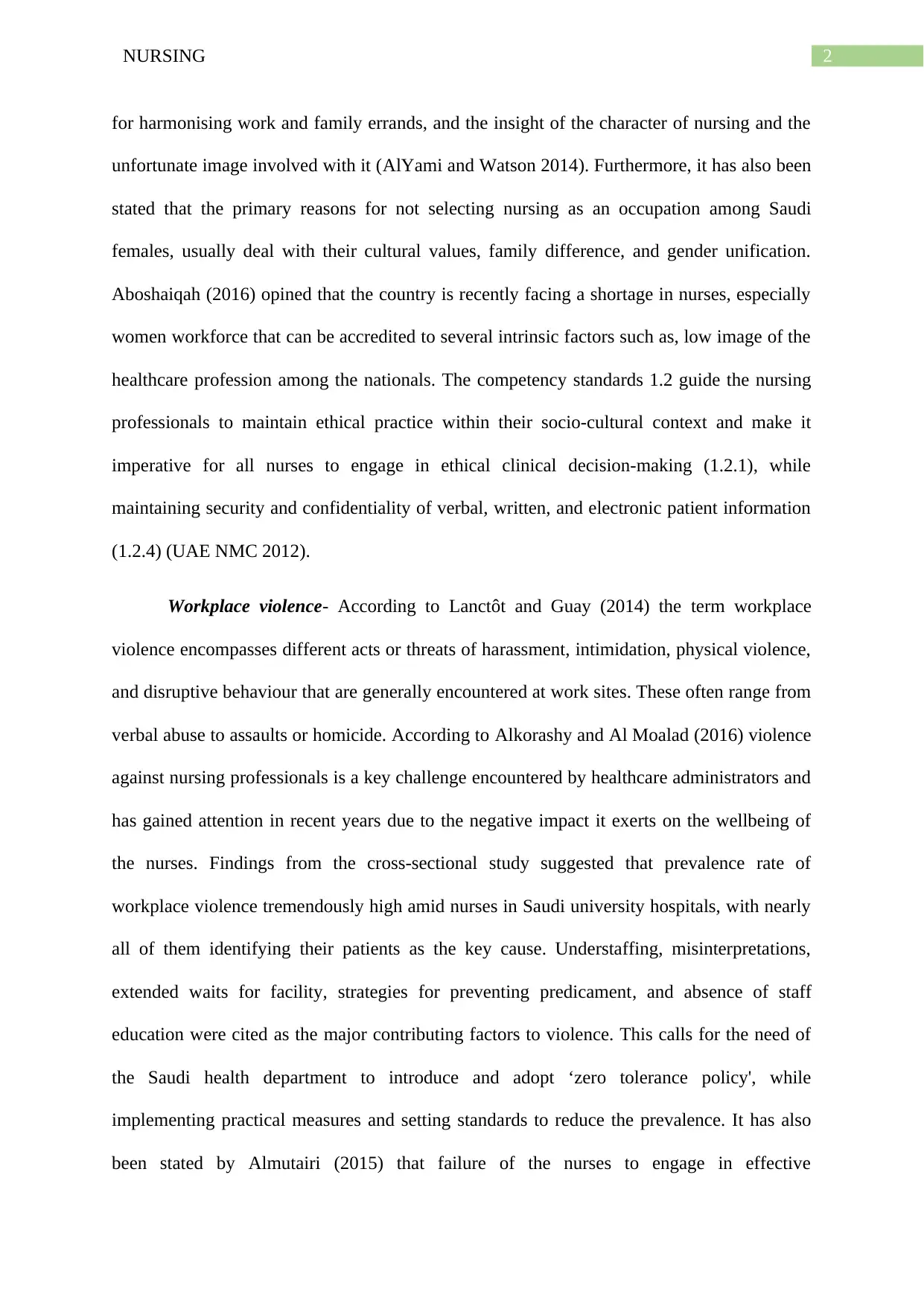
2NURSING
for harmonising work and family errands, and the insight of the character of nursing and the
unfortunate image involved with it (AlYami and Watson 2014). Furthermore, it has also been
stated that the primary reasons for not selecting nursing as an occupation among Saudi
females, usually deal with their cultural values, family difference, and gender unification.
Aboshaiqah (2016) opined that the country is recently facing a shortage in nurses, especially
women workforce that can be accredited to several intrinsic factors such as, low image of the
healthcare profession among the nationals. The competency standards 1.2 guide the nursing
professionals to maintain ethical practice within their socio-cultural context and make it
imperative for all nurses to engage in ethical clinical decision-making (1.2.1), while
maintaining security and confidentiality of verbal, written, and electronic patient information
(1.2.4) (UAE NMC 2012).
Workplace violence- According to Lanctôt and Guay (2014) the term workplace
violence encompasses different acts or threats of harassment, intimidation, physical violence,
and disruptive behaviour that are generally encountered at work sites. These often range from
verbal abuse to assaults or homicide. According to Alkorashy and Al Moalad (2016) violence
against nursing professionals is a key challenge encountered by healthcare administrators and
has gained attention in recent years due to the negative impact it exerts on the wellbeing of
the nurses. Findings from the cross-sectional study suggested that prevalence rate of
workplace violence tremendously high amid nurses in Saudi university hospitals, with nearly
all of them identifying their patients as the key cause. Understaffing, misinterpretations,
extended waits for facility, strategies for preventing predicament, and absence of staff
education were cited as the major contributing factors to violence. This calls for the need of
the Saudi health department to introduce and adopt ‘zero tolerance policy', while
implementing practical measures and setting standards to reduce the prevalence. It has also
been stated by Almutairi (2015) that failure of the nurses to engage in effective
for harmonising work and family errands, and the insight of the character of nursing and the
unfortunate image involved with it (AlYami and Watson 2014). Furthermore, it has also been
stated that the primary reasons for not selecting nursing as an occupation among Saudi
females, usually deal with their cultural values, family difference, and gender unification.
Aboshaiqah (2016) opined that the country is recently facing a shortage in nurses, especially
women workforce that can be accredited to several intrinsic factors such as, low image of the
healthcare profession among the nationals. The competency standards 1.2 guide the nursing
professionals to maintain ethical practice within their socio-cultural context and make it
imperative for all nurses to engage in ethical clinical decision-making (1.2.1), while
maintaining security and confidentiality of verbal, written, and electronic patient information
(1.2.4) (UAE NMC 2012).
Workplace violence- According to Lanctôt and Guay (2014) the term workplace
violence encompasses different acts or threats of harassment, intimidation, physical violence,
and disruptive behaviour that are generally encountered at work sites. These often range from
verbal abuse to assaults or homicide. According to Alkorashy and Al Moalad (2016) violence
against nursing professionals is a key challenge encountered by healthcare administrators and
has gained attention in recent years due to the negative impact it exerts on the wellbeing of
the nurses. Findings from the cross-sectional study suggested that prevalence rate of
workplace violence tremendously high amid nurses in Saudi university hospitals, with nearly
all of them identifying their patients as the key cause. Understaffing, misinterpretations,
extended waits for facility, strategies for preventing predicament, and absence of staff
education were cited as the major contributing factors to violence. This calls for the need of
the Saudi health department to introduce and adopt ‘zero tolerance policy', while
implementing practical measures and setting standards to reduce the prevalence. It has also
been stated by Almutairi (2015) that failure of the nurses to engage in effective
⊘ This is a preview!⊘
Do you want full access?
Subscribe today to unlock all pages.

Trusted by 1+ million students worldwide
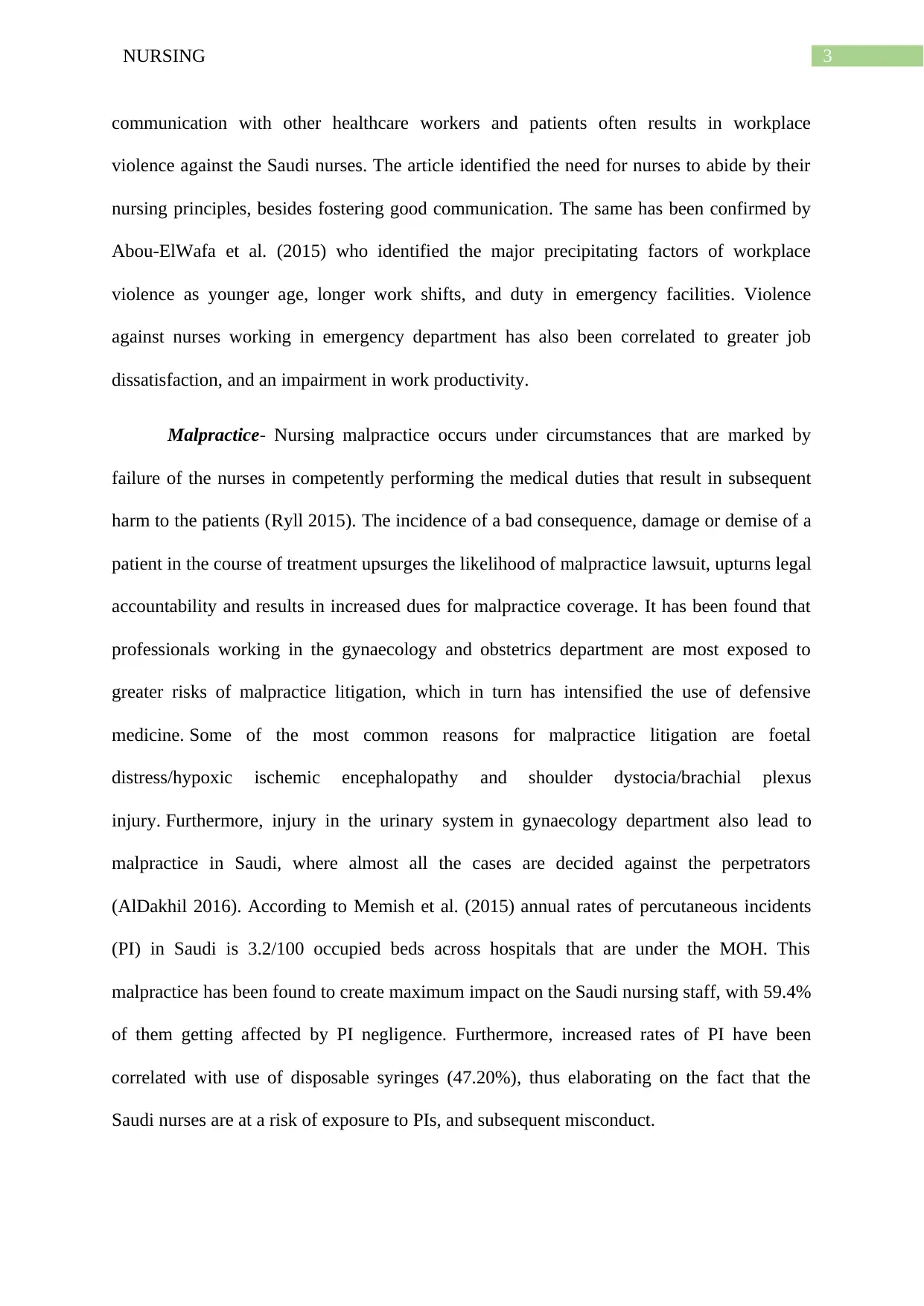
3NURSING
communication with other healthcare workers and patients often results in workplace
violence against the Saudi nurses. The article identified the need for nurses to abide by their
nursing principles, besides fostering good communication. The same has been confirmed by
Abou-ElWafa et al. (2015) who identified the major precipitating factors of workplace
violence as younger age, longer work shifts, and duty in emergency facilities. Violence
against nurses working in emergency department has also been correlated to greater job
dissatisfaction, and an impairment in work productivity.
Malpractice- Nursing malpractice occurs under circumstances that are marked by
failure of the nurses in competently performing the medical duties that result in subsequent
harm to the patients (Ryll 2015). The incidence of a bad consequence, damage or demise of a
patient in the course of treatment upsurges the likelihood of malpractice lawsuit, upturns legal
accountability and results in increased dues for malpractice coverage. It has been found that
professionals working in the gynaecology and obstetrics department are most exposed to
greater risks of malpractice litigation, which in turn has intensified the use of defensive
medicine. Some of the most common reasons for malpractice litigation are foetal
distress/hypoxic ischemic encephalopathy and shoulder dystocia/brachial plexus
injury. Furthermore, injury in the urinary system in gynaecology department also lead to
malpractice in Saudi, where almost all the cases are decided against the perpetrators
(AlDakhil 2016). According to Memish et al. (2015) annual rates of percutaneous incidents
(PI) in Saudi is 3.2/100 occupied beds across hospitals that are under the MOH. This
malpractice has been found to create maximum impact on the Saudi nursing staff, with 59.4%
of them getting affected by PI negligence. Furthermore, increased rates of PI have been
correlated with use of disposable syringes (47.20%), thus elaborating on the fact that the
Saudi nurses are at a risk of exposure to PIs, and subsequent misconduct.
communication with other healthcare workers and patients often results in workplace
violence against the Saudi nurses. The article identified the need for nurses to abide by their
nursing principles, besides fostering good communication. The same has been confirmed by
Abou-ElWafa et al. (2015) who identified the major precipitating factors of workplace
violence as younger age, longer work shifts, and duty in emergency facilities. Violence
against nurses working in emergency department has also been correlated to greater job
dissatisfaction, and an impairment in work productivity.
Malpractice- Nursing malpractice occurs under circumstances that are marked by
failure of the nurses in competently performing the medical duties that result in subsequent
harm to the patients (Ryll 2015). The incidence of a bad consequence, damage or demise of a
patient in the course of treatment upsurges the likelihood of malpractice lawsuit, upturns legal
accountability and results in increased dues for malpractice coverage. It has been found that
professionals working in the gynaecology and obstetrics department are most exposed to
greater risks of malpractice litigation, which in turn has intensified the use of defensive
medicine. Some of the most common reasons for malpractice litigation are foetal
distress/hypoxic ischemic encephalopathy and shoulder dystocia/brachial plexus
injury. Furthermore, injury in the urinary system in gynaecology department also lead to
malpractice in Saudi, where almost all the cases are decided against the perpetrators
(AlDakhil 2016). According to Memish et al. (2015) annual rates of percutaneous incidents
(PI) in Saudi is 3.2/100 occupied beds across hospitals that are under the MOH. This
malpractice has been found to create maximum impact on the Saudi nursing staff, with 59.4%
of them getting affected by PI negligence. Furthermore, increased rates of PI have been
correlated with use of disposable syringes (47.20%), thus elaborating on the fact that the
Saudi nurses are at a risk of exposure to PIs, and subsequent misconduct.
Paraphrase This Document
Need a fresh take? Get an instant paraphrase of this document with our AI Paraphraser
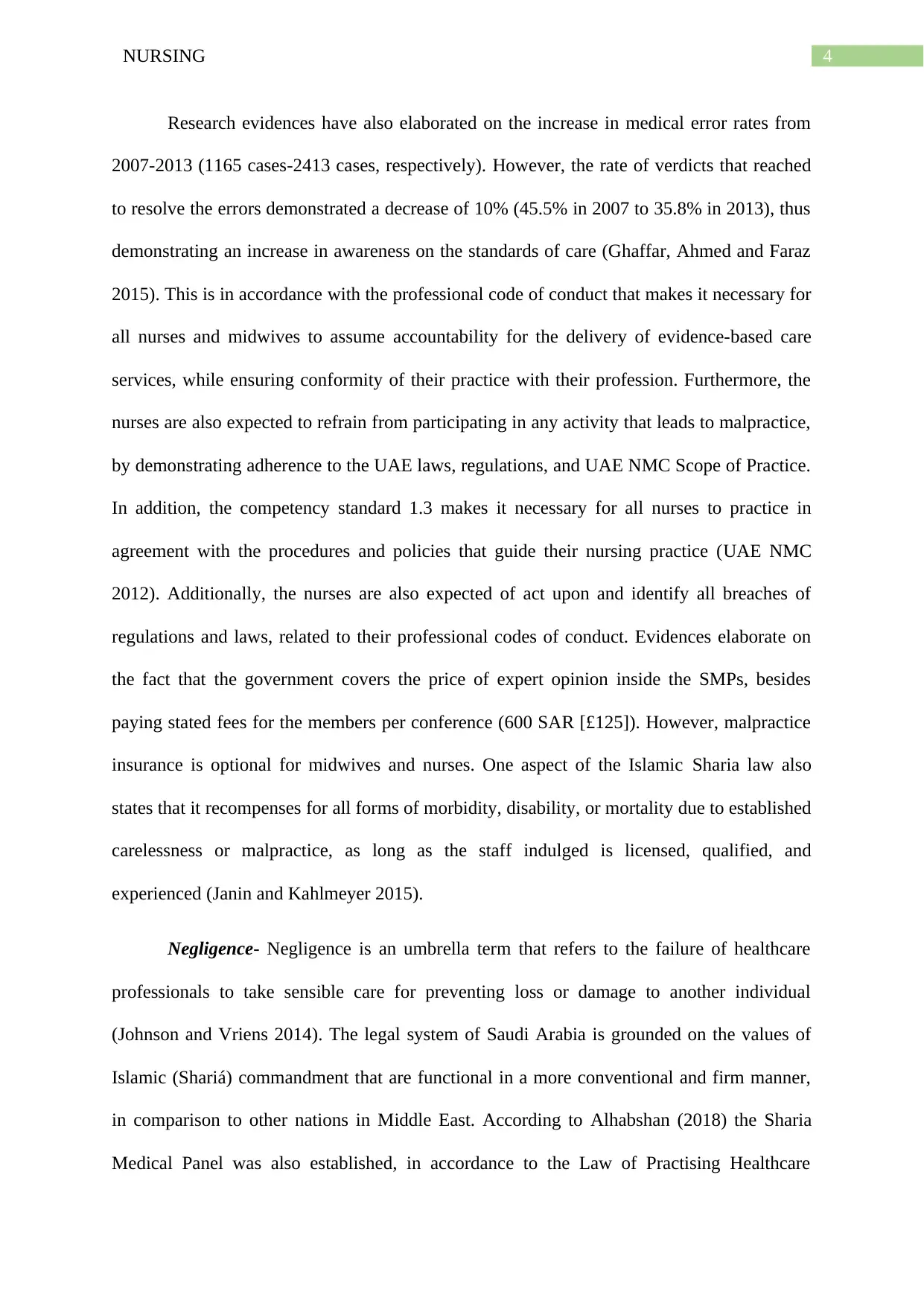
4NURSING
Research evidences have also elaborated on the increase in medical error rates from
2007-2013 (1165 cases-2413 cases, respectively). However, the rate of verdicts that reached
to resolve the errors demonstrated a decrease of 10% (45.5% in 2007 to 35.8% in 2013), thus
demonstrating an increase in awareness on the standards of care (Ghaffar, Ahmed and Faraz
2015). This is in accordance with the professional code of conduct that makes it necessary for
all nurses and midwives to assume accountability for the delivery of evidence-based care
services, while ensuring conformity of their practice with their profession. Furthermore, the
nurses are also expected to refrain from participating in any activity that leads to malpractice,
by demonstrating adherence to the UAE laws, regulations, and UAE NMC Scope of Practice.
In addition, the competency standard 1.3 makes it necessary for all nurses to practice in
agreement with the procedures and policies that guide their nursing practice (UAE NMC
2012). Additionally, the nurses are also expected of act upon and identify all breaches of
regulations and laws, related to their professional codes of conduct. Evidences elaborate on
the fact that the government covers the price of expert opinion inside the SMPs, besides
paying stated fees for the members per conference (600 SAR [£125]). However, malpractice
insurance is optional for midwives and nurses. One aspect of the Islamic Sharia law also
states that it recompenses for all forms of morbidity, disability, or mortality due to established
carelessness or malpractice, as long as the staff indulged is licensed, qualified, and
experienced (Janin and Kahlmeyer 2015).
Negligence- Negligence is an umbrella term that refers to the failure of healthcare
professionals to take sensible care for preventing loss or damage to another individual
(Johnson and Vriens 2014). The legal system of Saudi Arabia is grounded on the values of
Islamic (Shariá) commandment that are functional in a more conventional and firm manner,
in comparison to other nations in Middle East. According to Alhabshan (2018) the Sharia
Medical Panel was also established, in accordance to the Law of Practising Healthcare
Research evidences have also elaborated on the increase in medical error rates from
2007-2013 (1165 cases-2413 cases, respectively). However, the rate of verdicts that reached
to resolve the errors demonstrated a decrease of 10% (45.5% in 2007 to 35.8% in 2013), thus
demonstrating an increase in awareness on the standards of care (Ghaffar, Ahmed and Faraz
2015). This is in accordance with the professional code of conduct that makes it necessary for
all nurses and midwives to assume accountability for the delivery of evidence-based care
services, while ensuring conformity of their practice with their profession. Furthermore, the
nurses are also expected to refrain from participating in any activity that leads to malpractice,
by demonstrating adherence to the UAE laws, regulations, and UAE NMC Scope of Practice.
In addition, the competency standard 1.3 makes it necessary for all nurses to practice in
agreement with the procedures and policies that guide their nursing practice (UAE NMC
2012). Additionally, the nurses are also expected of act upon and identify all breaches of
regulations and laws, related to their professional codes of conduct. Evidences elaborate on
the fact that the government covers the price of expert opinion inside the SMPs, besides
paying stated fees for the members per conference (600 SAR [£125]). However, malpractice
insurance is optional for midwives and nurses. One aspect of the Islamic Sharia law also
states that it recompenses for all forms of morbidity, disability, or mortality due to established
carelessness or malpractice, as long as the staff indulged is licensed, qualified, and
experienced (Janin and Kahlmeyer 2015).
Negligence- Negligence is an umbrella term that refers to the failure of healthcare
professionals to take sensible care for preventing loss or damage to another individual
(Johnson and Vriens 2014). The legal system of Saudi Arabia is grounded on the values of
Islamic (Shariá) commandment that are functional in a more conventional and firm manner,
in comparison to other nations in Middle East. According to Alhabshan (2018) the Sharia
Medical Panel was also established, in accordance to the Law of Practising Healthcare
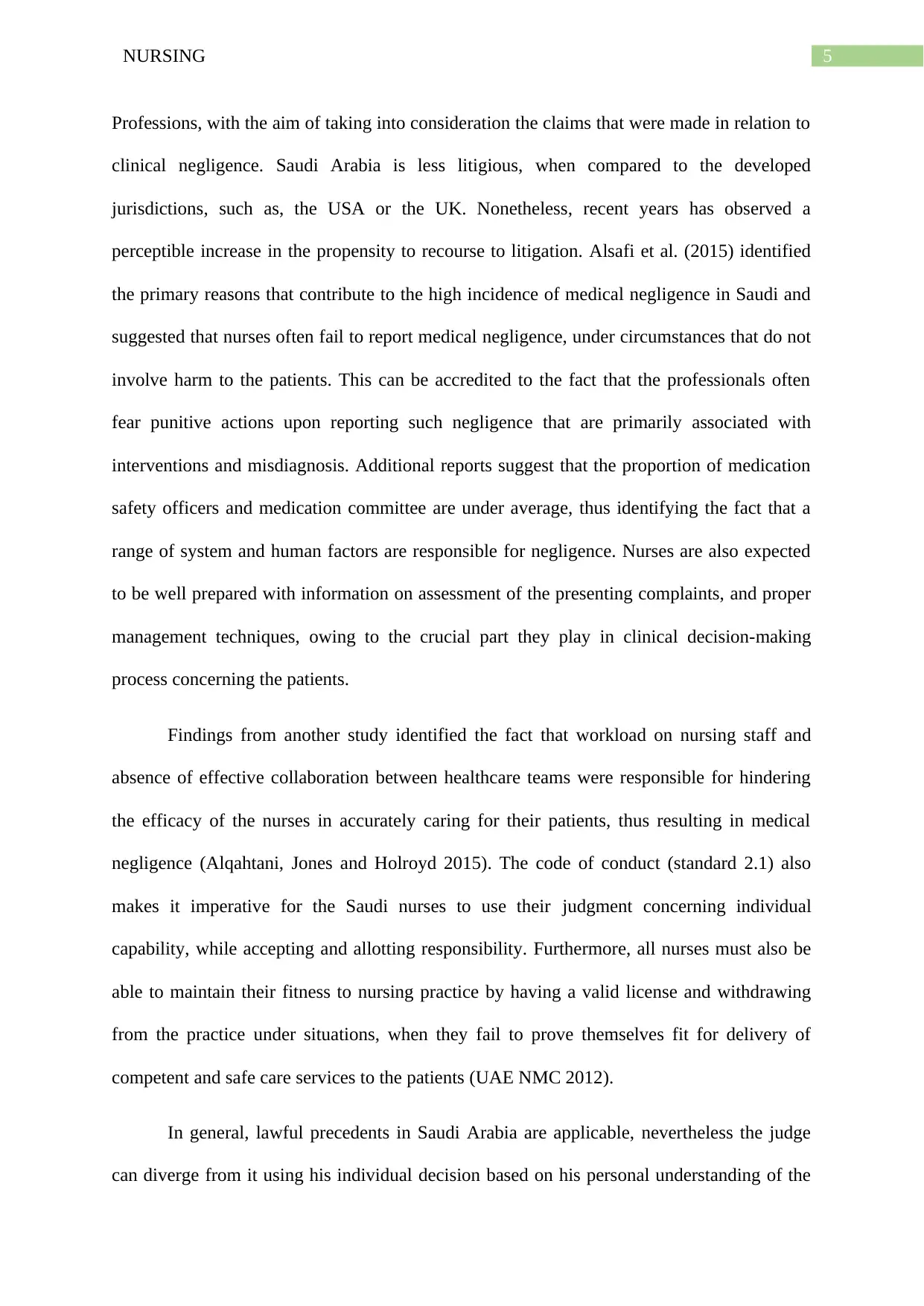
5NURSING
Professions, with the aim of taking into consideration the claims that were made in relation to
clinical negligence. Saudi Arabia is less litigious, when compared to the developed
jurisdictions, such as, the USA or the UK. Nonetheless, recent years has observed a
perceptible increase in the propensity to recourse to litigation. Alsafi et al. (2015) identified
the primary reasons that contribute to the high incidence of medical negligence in Saudi and
suggested that nurses often fail to report medical negligence, under circumstances that do not
involve harm to the patients. This can be accredited to the fact that the professionals often
fear punitive actions upon reporting such negligence that are primarily associated with
interventions and misdiagnosis. Additional reports suggest that the proportion of medication
safety officers and medication committee are under average, thus identifying the fact that a
range of system and human factors are responsible for negligence. Nurses are also expected
to be well prepared with information on assessment of the presenting complaints, and proper
management techniques, owing to the crucial part they play in clinical decision-making
process concerning the patients.
Findings from another study identified the fact that workload on nursing staff and
absence of effective collaboration between healthcare teams were responsible for hindering
the efficacy of the nurses in accurately caring for their patients, thus resulting in medical
negligence (Alqahtani, Jones and Holroyd 2015). The code of conduct (standard 2.1) also
makes it imperative for the Saudi nurses to use their judgment concerning individual
capability, while accepting and allotting responsibility. Furthermore, all nurses must also be
able to maintain their fitness to nursing practice by having a valid license and withdrawing
from the practice under situations, when they fail to prove themselves fit for delivery of
competent and safe care services to the patients (UAE NMC 2012).
In general, lawful precedents in Saudi Arabia are applicable, nevertheless the judge
can diverge from it using his individual decision based on his personal understanding of the
Professions, with the aim of taking into consideration the claims that were made in relation to
clinical negligence. Saudi Arabia is less litigious, when compared to the developed
jurisdictions, such as, the USA or the UK. Nonetheless, recent years has observed a
perceptible increase in the propensity to recourse to litigation. Alsafi et al. (2015) identified
the primary reasons that contribute to the high incidence of medical negligence in Saudi and
suggested that nurses often fail to report medical negligence, under circumstances that do not
involve harm to the patients. This can be accredited to the fact that the professionals often
fear punitive actions upon reporting such negligence that are primarily associated with
interventions and misdiagnosis. Additional reports suggest that the proportion of medication
safety officers and medication committee are under average, thus identifying the fact that a
range of system and human factors are responsible for negligence. Nurses are also expected
to be well prepared with information on assessment of the presenting complaints, and proper
management techniques, owing to the crucial part they play in clinical decision-making
process concerning the patients.
Findings from another study identified the fact that workload on nursing staff and
absence of effective collaboration between healthcare teams were responsible for hindering
the efficacy of the nurses in accurately caring for their patients, thus resulting in medical
negligence (Alqahtani, Jones and Holroyd 2015). The code of conduct (standard 2.1) also
makes it imperative for the Saudi nurses to use their judgment concerning individual
capability, while accepting and allotting responsibility. Furthermore, all nurses must also be
able to maintain their fitness to nursing practice by having a valid license and withdrawing
from the practice under situations, when they fail to prove themselves fit for delivery of
competent and safe care services to the patients (UAE NMC 2012).
In general, lawful precedents in Saudi Arabia are applicable, nevertheless the judge
can diverge from it using his individual decision based on his personal understanding of the
⊘ This is a preview!⊘
Do you want full access?
Subscribe today to unlock all pages.

Trusted by 1+ million students worldwide
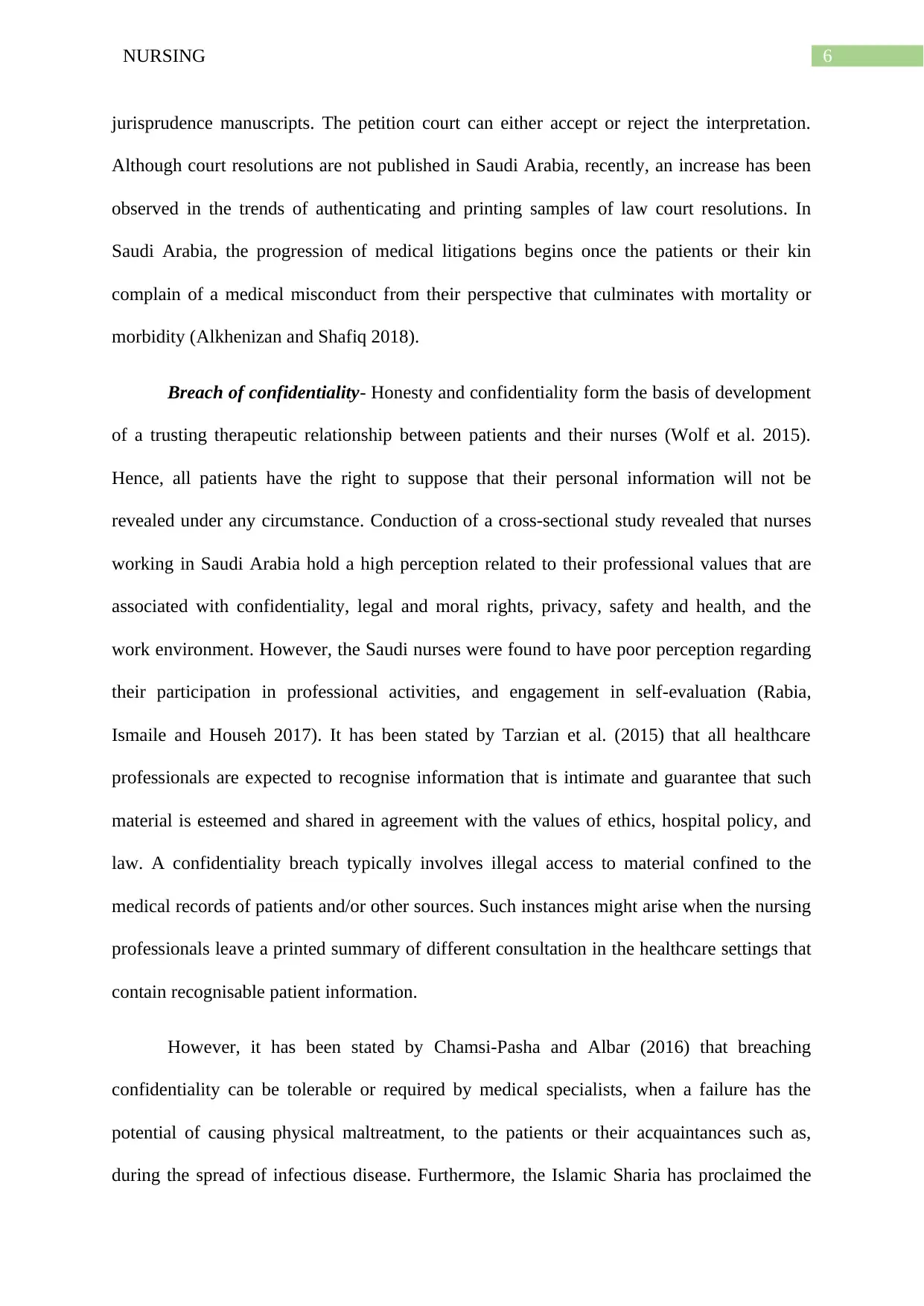
6NURSING
jurisprudence manuscripts. The petition court can either accept or reject the interpretation.
Although court resolutions are not published in Saudi Arabia, recently, an increase has been
observed in the trends of authenticating and printing samples of law court resolutions. In
Saudi Arabia, the progression of medical litigations begins once the patients or their kin
complain of a medical misconduct from their perspective that culminates with mortality or
morbidity (Alkhenizan and Shafiq 2018).
Breach of confidentiality- Honesty and confidentiality form the basis of development
of a trusting therapeutic relationship between patients and their nurses (Wolf et al. 2015).
Hence, all patients have the right to suppose that their personal information will not be
revealed under any circumstance. Conduction of a cross-sectional study revealed that nurses
working in Saudi Arabia hold a high perception related to their professional values that are
associated with confidentiality, legal and moral rights, privacy, safety and health, and the
work environment. However, the Saudi nurses were found to have poor perception regarding
their participation in professional activities, and engagement in self-evaluation (Rabia,
Ismaile and Househ 2017). It has been stated by Tarzian et al. (2015) that all healthcare
professionals are expected to recognise information that is intimate and guarantee that such
material is esteemed and shared in agreement with the values of ethics, hospital policy, and
law. A confidentiality breach typically involves illegal access to material confined to the
medical records of patients and/or other sources. Such instances might arise when the nursing
professionals leave a printed summary of different consultation in the healthcare settings that
contain recognisable patient information.
However, it has been stated by Chamsi-Pasha and Albar (2016) that breaching
confidentiality can be tolerable or required by medical specialists, when a failure has the
potential of causing physical maltreatment, to the patients or their acquaintances such as,
during the spread of infectious disease. Furthermore, the Islamic Sharia has proclaimed the
jurisprudence manuscripts. The petition court can either accept or reject the interpretation.
Although court resolutions are not published in Saudi Arabia, recently, an increase has been
observed in the trends of authenticating and printing samples of law court resolutions. In
Saudi Arabia, the progression of medical litigations begins once the patients or their kin
complain of a medical misconduct from their perspective that culminates with mortality or
morbidity (Alkhenizan and Shafiq 2018).
Breach of confidentiality- Honesty and confidentiality form the basis of development
of a trusting therapeutic relationship between patients and their nurses (Wolf et al. 2015).
Hence, all patients have the right to suppose that their personal information will not be
revealed under any circumstance. Conduction of a cross-sectional study revealed that nurses
working in Saudi Arabia hold a high perception related to their professional values that are
associated with confidentiality, legal and moral rights, privacy, safety and health, and the
work environment. However, the Saudi nurses were found to have poor perception regarding
their participation in professional activities, and engagement in self-evaluation (Rabia,
Ismaile and Househ 2017). It has been stated by Tarzian et al. (2015) that all healthcare
professionals are expected to recognise information that is intimate and guarantee that such
material is esteemed and shared in agreement with the values of ethics, hospital policy, and
law. A confidentiality breach typically involves illegal access to material confined to the
medical records of patients and/or other sources. Such instances might arise when the nursing
professionals leave a printed summary of different consultation in the healthcare settings that
contain recognisable patient information.
However, it has been stated by Chamsi-Pasha and Albar (2016) that breaching
confidentiality can be tolerable or required by medical specialists, when a failure has the
potential of causing physical maltreatment, to the patients or their acquaintances such as,
during the spread of infectious disease. Furthermore, the Islamic Sharia has proclaimed the
Paraphrase This Document
Need a fresh take? Get an instant paraphrase of this document with our AI Paraphraser
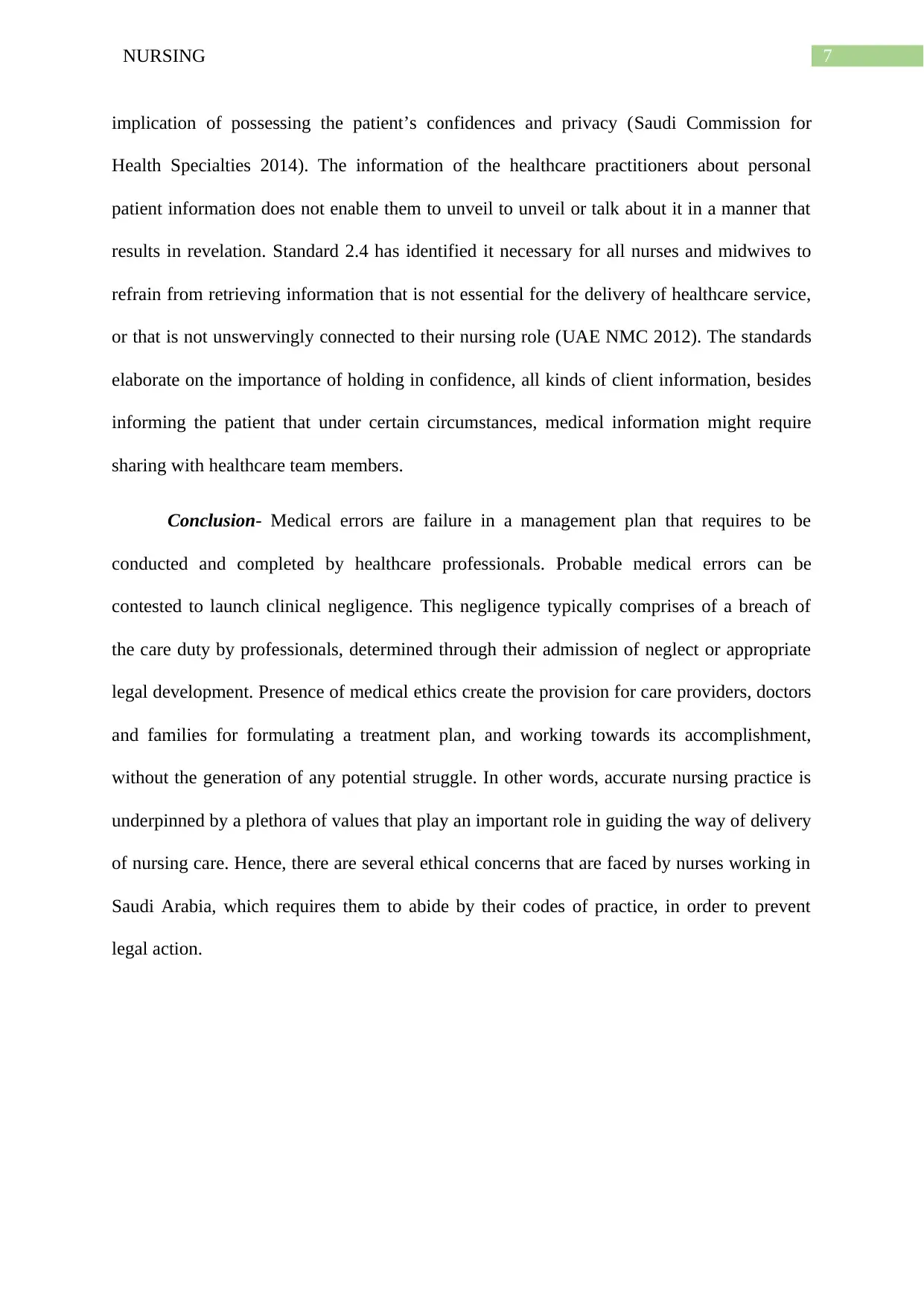
7NURSING
implication of possessing the patient’s confidences and privacy (Saudi Commission for
Health Specialties 2014). The information of the healthcare practitioners about personal
patient information does not enable them to unveil to unveil or talk about it in a manner that
results in revelation. Standard 2.4 has identified it necessary for all nurses and midwives to
refrain from retrieving information that is not essential for the delivery of healthcare service,
or that is not unswervingly connected to their nursing role (UAE NMC 2012). The standards
elaborate on the importance of holding in confidence, all kinds of client information, besides
informing the patient that under certain circumstances, medical information might require
sharing with healthcare team members.
Conclusion- Medical errors are failure in a management plan that requires to be
conducted and completed by healthcare professionals. Probable medical errors can be
contested to launch clinical negligence. This negligence typically comprises of a breach of
the care duty by professionals, determined through their admission of neglect or appropriate
legal development. Presence of medical ethics create the provision for care providers, doctors
and families for formulating a treatment plan, and working towards its accomplishment,
without the generation of any potential struggle. In other words, accurate nursing practice is
underpinned by a plethora of values that play an important role in guiding the way of delivery
of nursing care. Hence, there are several ethical concerns that are faced by nurses working in
Saudi Arabia, which requires them to abide by their codes of practice, in order to prevent
legal action.
implication of possessing the patient’s confidences and privacy (Saudi Commission for
Health Specialties 2014). The information of the healthcare practitioners about personal
patient information does not enable them to unveil to unveil or talk about it in a manner that
results in revelation. Standard 2.4 has identified it necessary for all nurses and midwives to
refrain from retrieving information that is not essential for the delivery of healthcare service,
or that is not unswervingly connected to their nursing role (UAE NMC 2012). The standards
elaborate on the importance of holding in confidence, all kinds of client information, besides
informing the patient that under certain circumstances, medical information might require
sharing with healthcare team members.
Conclusion- Medical errors are failure in a management plan that requires to be
conducted and completed by healthcare professionals. Probable medical errors can be
contested to launch clinical negligence. This negligence typically comprises of a breach of
the care duty by professionals, determined through their admission of neglect or appropriate
legal development. Presence of medical ethics create the provision for care providers, doctors
and families for formulating a treatment plan, and working towards its accomplishment,
without the generation of any potential struggle. In other words, accurate nursing practice is
underpinned by a plethora of values that play an important role in guiding the way of delivery
of nursing care. Hence, there are several ethical concerns that are faced by nurses working in
Saudi Arabia, which requires them to abide by their codes of practice, in order to prevent
legal action.
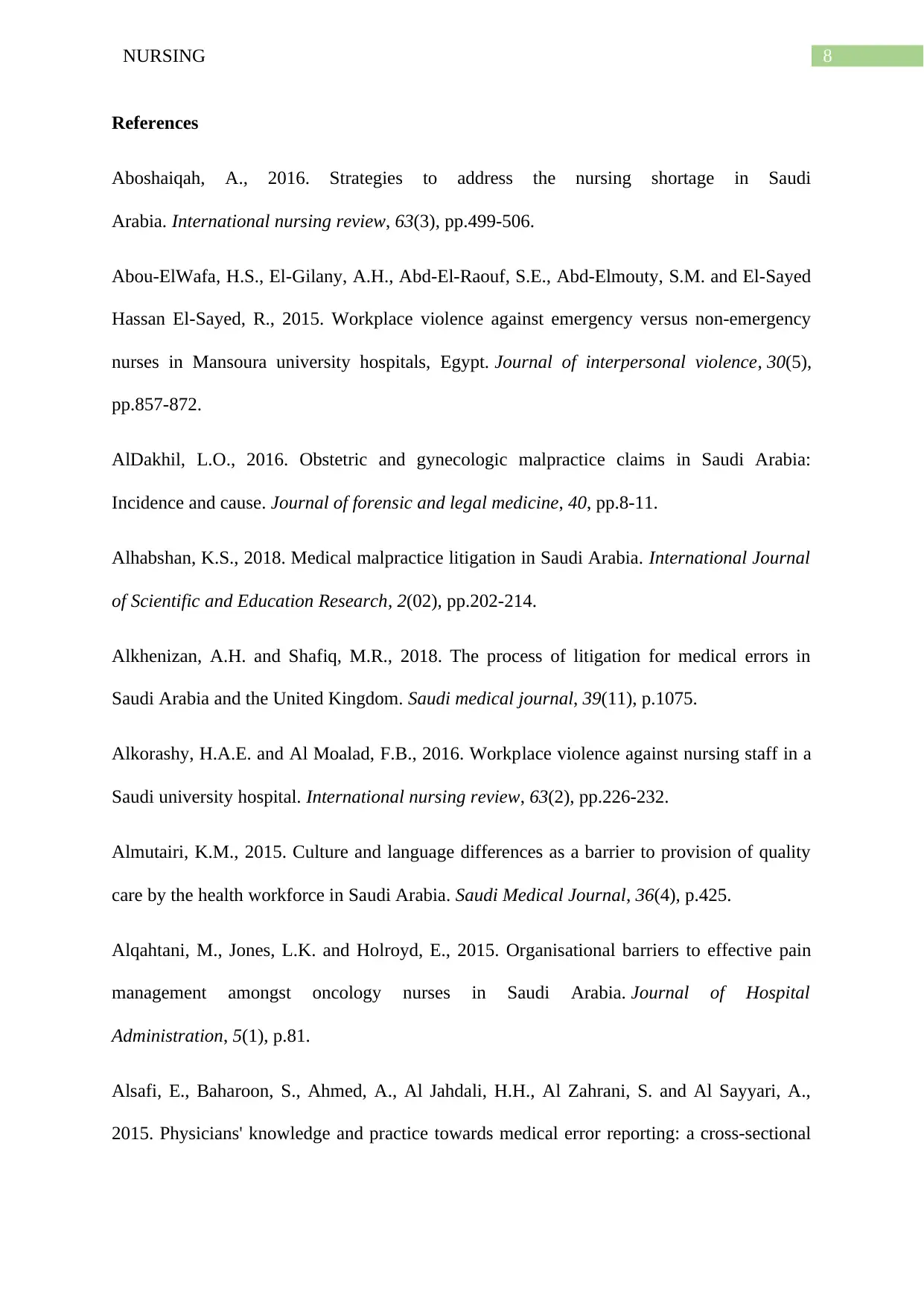
8NURSING
References
Aboshaiqah, A., 2016. Strategies to address the nursing shortage in Saudi
Arabia. International nursing review, 63(3), pp.499-506.
Abou-ElWafa, H.S., El-Gilany, A.H., Abd-El-Raouf, S.E., Abd-Elmouty, S.M. and El-Sayed
Hassan El-Sayed, R., 2015. Workplace violence against emergency versus non-emergency
nurses in Mansoura university hospitals, Egypt. Journal of interpersonal violence, 30(5),
pp.857-872.
AlDakhil, L.O., 2016. Obstetric and gynecologic malpractice claims in Saudi Arabia:
Incidence and cause. Journal of forensic and legal medicine, 40, pp.8-11.
Alhabshan, K.S., 2018. Medical malpractice litigation in Saudi Arabia. International Journal
of Scientific and Education Research, 2(02), pp.202-214.
Alkhenizan, A.H. and Shafiq, M.R., 2018. The process of litigation for medical errors in
Saudi Arabia and the United Kingdom. Saudi medical journal, 39(11), p.1075.
Alkorashy, H.A.E. and Al Moalad, F.B., 2016. Workplace violence against nursing staff in a
Saudi university hospital. International nursing review, 63(2), pp.226-232.
Almutairi, K.M., 2015. Culture and language differences as a barrier to provision of quality
care by the health workforce in Saudi Arabia. Saudi Medical Journal, 36(4), p.425.
Alqahtani, M., Jones, L.K. and Holroyd, E., 2015. Organisational barriers to effective pain
management amongst oncology nurses in Saudi Arabia. Journal of Hospital
Administration, 5(1), p.81.
Alsafi, E., Baharoon, S., Ahmed, A., Al Jahdali, H.H., Al Zahrani, S. and Al Sayyari, A.,
2015. Physicians' knowledge and practice towards medical error reporting: a cross-sectional
References
Aboshaiqah, A., 2016. Strategies to address the nursing shortage in Saudi
Arabia. International nursing review, 63(3), pp.499-506.
Abou-ElWafa, H.S., El-Gilany, A.H., Abd-El-Raouf, S.E., Abd-Elmouty, S.M. and El-Sayed
Hassan El-Sayed, R., 2015. Workplace violence against emergency versus non-emergency
nurses in Mansoura university hospitals, Egypt. Journal of interpersonal violence, 30(5),
pp.857-872.
AlDakhil, L.O., 2016. Obstetric and gynecologic malpractice claims in Saudi Arabia:
Incidence and cause. Journal of forensic and legal medicine, 40, pp.8-11.
Alhabshan, K.S., 2018. Medical malpractice litigation in Saudi Arabia. International Journal
of Scientific and Education Research, 2(02), pp.202-214.
Alkhenizan, A.H. and Shafiq, M.R., 2018. The process of litigation for medical errors in
Saudi Arabia and the United Kingdom. Saudi medical journal, 39(11), p.1075.
Alkorashy, H.A.E. and Al Moalad, F.B., 2016. Workplace violence against nursing staff in a
Saudi university hospital. International nursing review, 63(2), pp.226-232.
Almutairi, K.M., 2015. Culture and language differences as a barrier to provision of quality
care by the health workforce in Saudi Arabia. Saudi Medical Journal, 36(4), p.425.
Alqahtani, M., Jones, L.K. and Holroyd, E., 2015. Organisational barriers to effective pain
management amongst oncology nurses in Saudi Arabia. Journal of Hospital
Administration, 5(1), p.81.
Alsafi, E., Baharoon, S., Ahmed, A., Al Jahdali, H.H., Al Zahrani, S. and Al Sayyari, A.,
2015. Physicians' knowledge and practice towards medical error reporting: a cross-sectional
⊘ This is a preview!⊘
Do you want full access?
Subscribe today to unlock all pages.

Trusted by 1+ million students worldwide
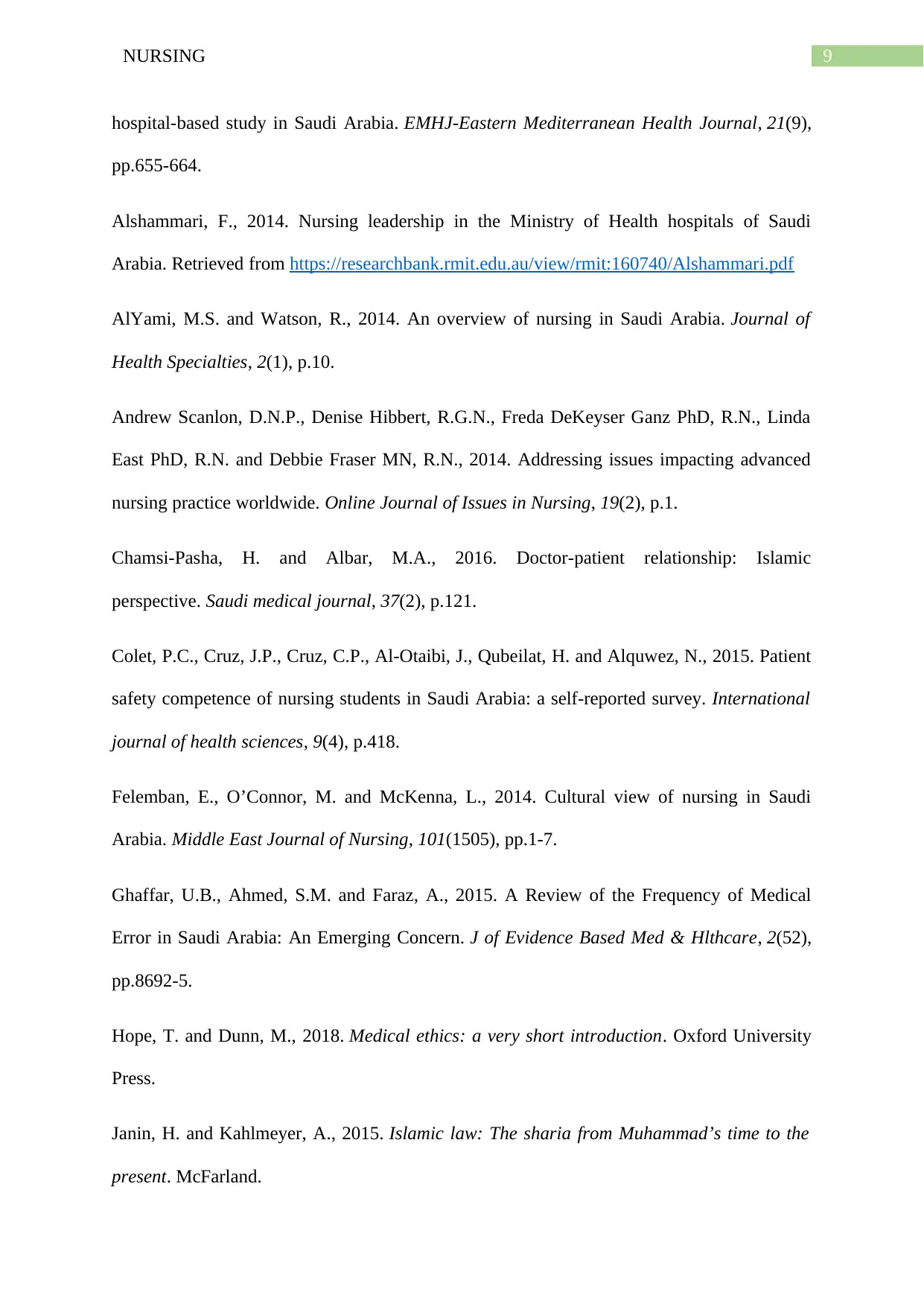
9NURSING
hospital-based study in Saudi Arabia. EMHJ-Eastern Mediterranean Health Journal, 21(9),
pp.655-664.
Alshammari, F., 2014. Nursing leadership in the Ministry of Health hospitals of Saudi
Arabia. Retrieved from https://researchbank.rmit.edu.au/view/rmit:160740/Alshammari.pdf
AlYami, M.S. and Watson, R., 2014. An overview of nursing in Saudi Arabia. Journal of
Health Specialties, 2(1), p.10.
Andrew Scanlon, D.N.P., Denise Hibbert, R.G.N., Freda DeKeyser Ganz PhD, R.N., Linda
East PhD, R.N. and Debbie Fraser MN, R.N., 2014. Addressing issues impacting advanced
nursing practice worldwide. Online Journal of Issues in Nursing, 19(2), p.1.
Chamsi-Pasha, H. and Albar, M.A., 2016. Doctor-patient relationship: Islamic
perspective. Saudi medical journal, 37(2), p.121.
Colet, P.C., Cruz, J.P., Cruz, C.P., Al-Otaibi, J., Qubeilat, H. and Alquwez, N., 2015. Patient
safety competence of nursing students in Saudi Arabia: a self-reported survey. International
journal of health sciences, 9(4), p.418.
Felemban, E., O’Connor, M. and McKenna, L., 2014. Cultural view of nursing in Saudi
Arabia. Middle East Journal of Nursing, 101(1505), pp.1-7.
Ghaffar, U.B., Ahmed, S.M. and Faraz, A., 2015. A Review of the Frequency of Medical
Error in Saudi Arabia: An Emerging Concern. J of Evidence Based Med & Hlthcare, 2(52),
pp.8692-5.
Hope, T. and Dunn, M., 2018. Medical ethics: a very short introduction. Oxford University
Press.
Janin, H. and Kahlmeyer, A., 2015. Islamic law: The sharia from Muhammad’s time to the
present. McFarland.
hospital-based study in Saudi Arabia. EMHJ-Eastern Mediterranean Health Journal, 21(9),
pp.655-664.
Alshammari, F., 2014. Nursing leadership in the Ministry of Health hospitals of Saudi
Arabia. Retrieved from https://researchbank.rmit.edu.au/view/rmit:160740/Alshammari.pdf
AlYami, M.S. and Watson, R., 2014. An overview of nursing in Saudi Arabia. Journal of
Health Specialties, 2(1), p.10.
Andrew Scanlon, D.N.P., Denise Hibbert, R.G.N., Freda DeKeyser Ganz PhD, R.N., Linda
East PhD, R.N. and Debbie Fraser MN, R.N., 2014. Addressing issues impacting advanced
nursing practice worldwide. Online Journal of Issues in Nursing, 19(2), p.1.
Chamsi-Pasha, H. and Albar, M.A., 2016. Doctor-patient relationship: Islamic
perspective. Saudi medical journal, 37(2), p.121.
Colet, P.C., Cruz, J.P., Cruz, C.P., Al-Otaibi, J., Qubeilat, H. and Alquwez, N., 2015. Patient
safety competence of nursing students in Saudi Arabia: a self-reported survey. International
journal of health sciences, 9(4), p.418.
Felemban, E., O’Connor, M. and McKenna, L., 2014. Cultural view of nursing in Saudi
Arabia. Middle East Journal of Nursing, 101(1505), pp.1-7.
Ghaffar, U.B., Ahmed, S.M. and Faraz, A., 2015. A Review of the Frequency of Medical
Error in Saudi Arabia: An Emerging Concern. J of Evidence Based Med & Hlthcare, 2(52),
pp.8692-5.
Hope, T. and Dunn, M., 2018. Medical ethics: a very short introduction. Oxford University
Press.
Janin, H. and Kahlmeyer, A., 2015. Islamic law: The sharia from Muhammad’s time to the
present. McFarland.
Paraphrase This Document
Need a fresh take? Get an instant paraphrase of this document with our AI Paraphraser
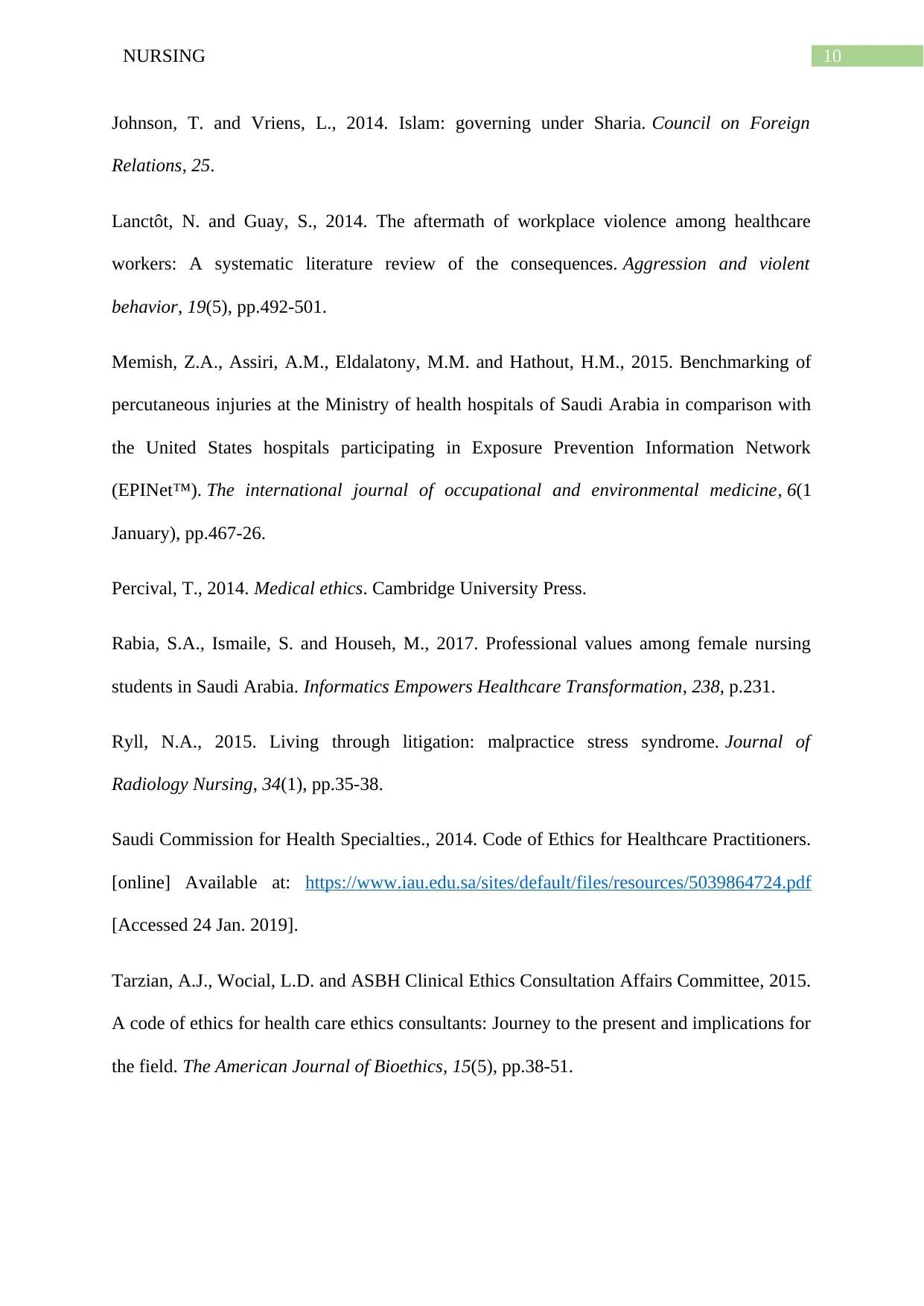
10NURSING
Johnson, T. and Vriens, L., 2014. Islam: governing under Sharia. Council on Foreign
Relations, 25.
Lanctôt, N. and Guay, S., 2014. The aftermath of workplace violence among healthcare
workers: A systematic literature review of the consequences. Aggression and violent
behavior, 19(5), pp.492-501.
Memish, Z.A., Assiri, A.M., Eldalatony, M.M. and Hathout, H.M., 2015. Benchmarking of
percutaneous injuries at the Ministry of health hospitals of Saudi Arabia in comparison with
the United States hospitals participating in Exposure Prevention Information Network
(EPINet™). The international journal of occupational and environmental medicine, 6(1
January), pp.467-26.
Percival, T., 2014. Medical ethics. Cambridge University Press.
Rabia, S.A., Ismaile, S. and Househ, M., 2017. Professional values among female nursing
students in Saudi Arabia. Informatics Empowers Healthcare Transformation, 238, p.231.
Ryll, N.A., 2015. Living through litigation: malpractice stress syndrome. Journal of
Radiology Nursing, 34(1), pp.35-38.
Saudi Commission for Health Specialties., 2014. Code of Ethics for Healthcare Practitioners.
[online] Available at: https://www.iau.edu.sa/sites/default/files/resources/5039864724.pdf
[Accessed 24 Jan. 2019].
Tarzian, A.J., Wocial, L.D. and ASBH Clinical Ethics Consultation Affairs Committee, 2015.
A code of ethics for health care ethics consultants: Journey to the present and implications for
the field. The American Journal of Bioethics, 15(5), pp.38-51.
Johnson, T. and Vriens, L., 2014. Islam: governing under Sharia. Council on Foreign
Relations, 25.
Lanctôt, N. and Guay, S., 2014. The aftermath of workplace violence among healthcare
workers: A systematic literature review of the consequences. Aggression and violent
behavior, 19(5), pp.492-501.
Memish, Z.A., Assiri, A.M., Eldalatony, M.M. and Hathout, H.M., 2015. Benchmarking of
percutaneous injuries at the Ministry of health hospitals of Saudi Arabia in comparison with
the United States hospitals participating in Exposure Prevention Information Network
(EPINet™). The international journal of occupational and environmental medicine, 6(1
January), pp.467-26.
Percival, T., 2014. Medical ethics. Cambridge University Press.
Rabia, S.A., Ismaile, S. and Househ, M., 2017. Professional values among female nursing
students in Saudi Arabia. Informatics Empowers Healthcare Transformation, 238, p.231.
Ryll, N.A., 2015. Living through litigation: malpractice stress syndrome. Journal of
Radiology Nursing, 34(1), pp.35-38.
Saudi Commission for Health Specialties., 2014. Code of Ethics for Healthcare Practitioners.
[online] Available at: https://www.iau.edu.sa/sites/default/files/resources/5039864724.pdf
[Accessed 24 Jan. 2019].
Tarzian, A.J., Wocial, L.D. and ASBH Clinical Ethics Consultation Affairs Committee, 2015.
A code of ethics for health care ethics consultants: Journey to the present and implications for
the field. The American Journal of Bioethics, 15(5), pp.38-51.
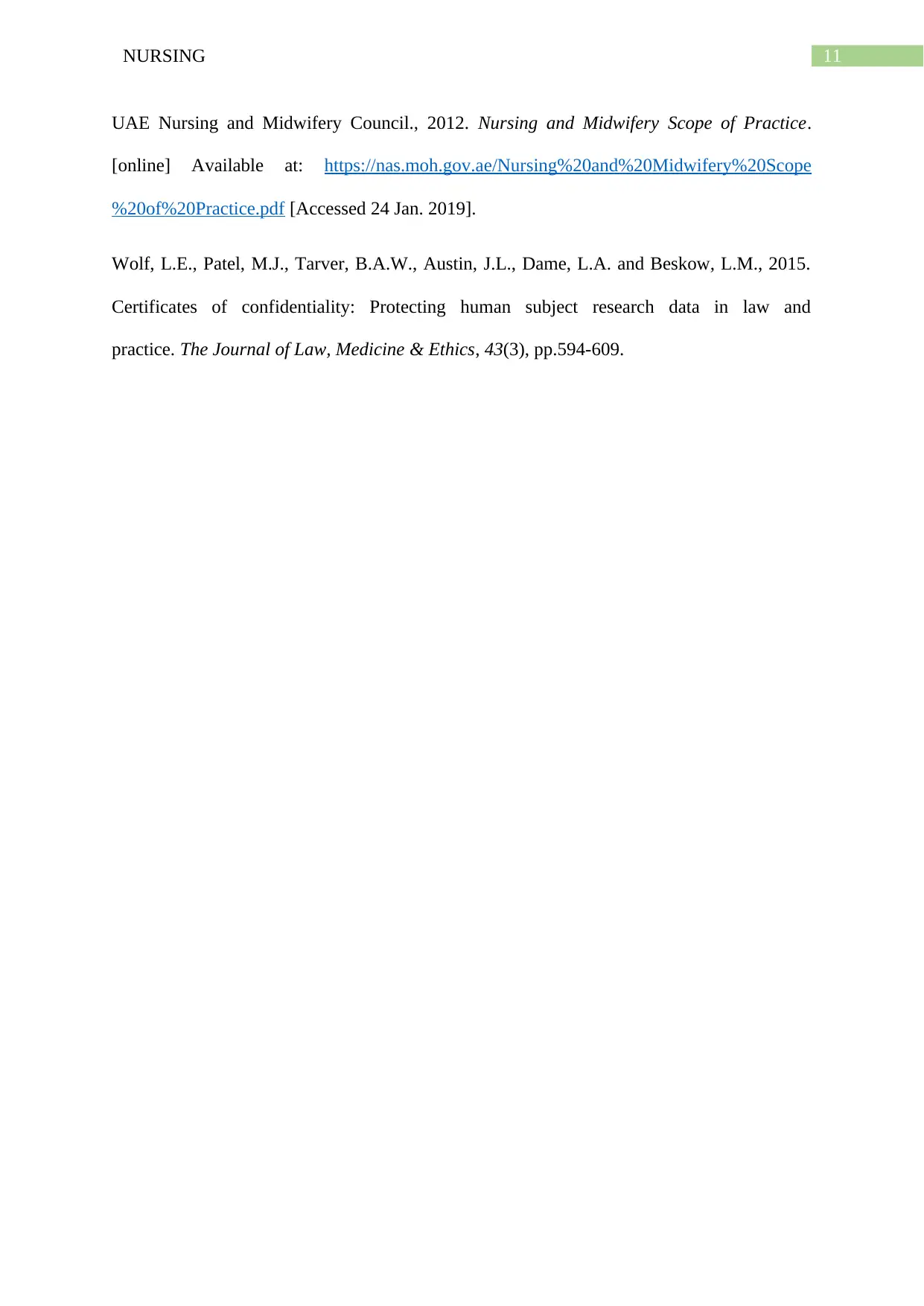
11NURSING
UAE Nursing and Midwifery Council., 2012. Nursing and Midwifery Scope of Practice.
[online] Available at: https://nas.moh.gov.ae/Nursing%20and%20Midwifery%20Scope
%20of%20Practice.pdf [Accessed 24 Jan. 2019].
Wolf, L.E., Patel, M.J., Tarver, B.A.W., Austin, J.L., Dame, L.A. and Beskow, L.M., 2015.
Certificates of confidentiality: Protecting human subject research data in law and
practice. The Journal of Law, Medicine & Ethics, 43(3), pp.594-609.
UAE Nursing and Midwifery Council., 2012. Nursing and Midwifery Scope of Practice.
[online] Available at: https://nas.moh.gov.ae/Nursing%20and%20Midwifery%20Scope
%20of%20Practice.pdf [Accessed 24 Jan. 2019].
Wolf, L.E., Patel, M.J., Tarver, B.A.W., Austin, J.L., Dame, L.A. and Beskow, L.M., 2015.
Certificates of confidentiality: Protecting human subject research data in law and
practice. The Journal of Law, Medicine & Ethics, 43(3), pp.594-609.
⊘ This is a preview!⊘
Do you want full access?
Subscribe today to unlock all pages.

Trusted by 1+ million students worldwide
1 out of 12
Related Documents
Your All-in-One AI-Powered Toolkit for Academic Success.
+13062052269
info@desklib.com
Available 24*7 on WhatsApp / Email
![[object Object]](/_next/static/media/star-bottom.7253800d.svg)
Unlock your academic potential
Copyright © 2020–2025 A2Z Services. All Rights Reserved. Developed and managed by ZUCOL.





